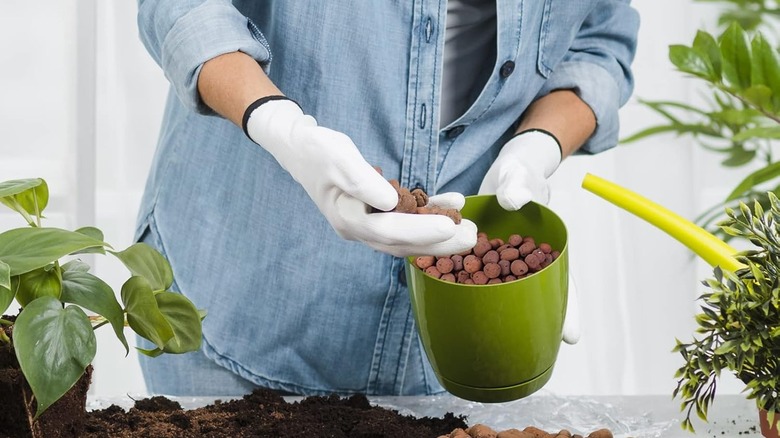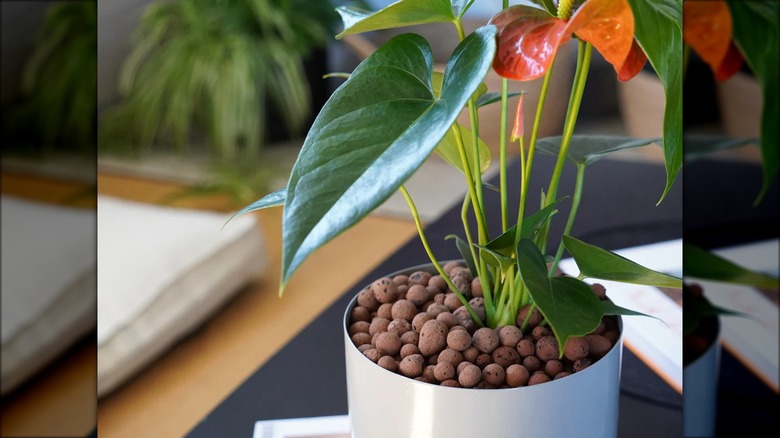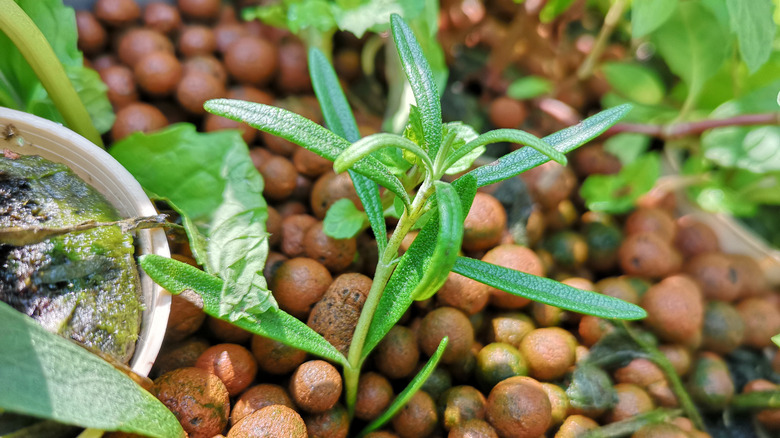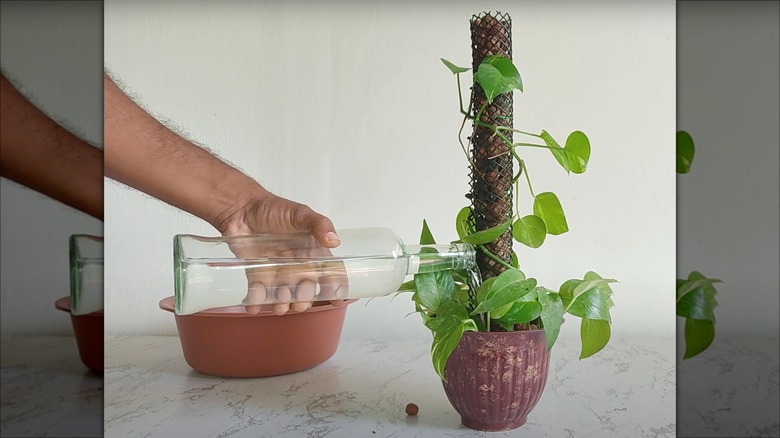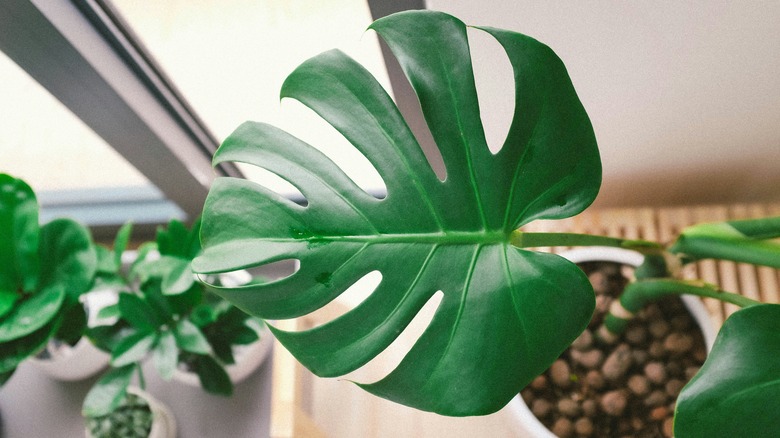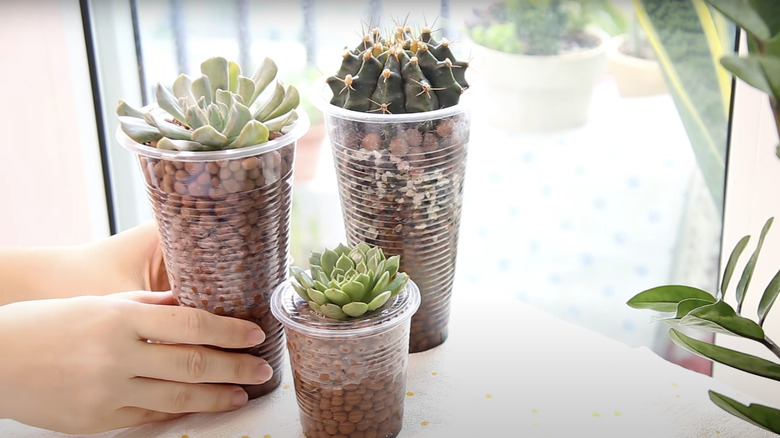Mess-Free Ways To Use LECA To Grow Indoor Plants Without Soil
We may receive a commission on purchases made from links.
Although it's been patented since 1918, LECA, or lightweight expanded clay aggregate, has grown enormously popular in recent years. TikTok hobby gardeners and hydroponics experts alike rave about the unique growing medium, which is essentially comprised of tiny baked clay balls that slightly expand when soaked in water. That's the first step to using LECA to propagate or grow thriving plants. The water absorbed by the clay balls is then used by your plants as they need hydration, which is especially helpful for anyone who tends to overwater. Although you'll need to regularly flush your LECA potted plants, and add liquid nutrients occasionally to nourish them, there are endless mess-free ways to use LECA to grow indoor plants without soil.
LECA is available from home improvement stores, specialty garden suppliers, and online. The unexpected potting soil replacement that houseplant enthusiasts are loving, it typically costs three to four times as much as garden soil, but eliminates many of the associated problems. Unlike soil, which can spill, get under your fingernails, or make a muddy mess to clean up, you'll only have to deal with dust or debris from LECA when soaking and occasionally rinsing the clay balls. Because it's sterile, inorganic, and has no nutritive value of its own, pests are less common when plants are potted in LECA, too. Whether you want to modernize the look of your indoor plants or keep a closer eye on varieties that are prone to root rot, switching from messy soil to LECA can help.
LECA is ideal for some indoor plants
One of the reasons LECA has become so popular is because it's easy and low maintenance, which works especially well for plant parents who are newbies, frequent travelers, or just plain busy. Instead of compact soil that you only really examine when your plants need to be repotted (or worse, when they've died), using clay balls in a clear container allows you to continuously monitor water levels and overall root health. LECA also provides outstanding aeration for plant roots, which is important if you like to grow philodendrons, alocasias, or other plants that have large roots or don't thrive when root-bound.
If you have existing houseplants that are currently growing in soil, you'll want to do careful research and preparation before switching them over to LECA. Horticulture expert Jayson Opgenorth told Martha Stewart, "Think of replacing soil as open-heart surgery versus up-potting, which is more like mending a broken bone. Both are necessary, but weigh out the risk factors." Some plants will make the transition from soil to LECA better than others. You can help ease the transition making sure you gently, but thoroughly, remove all the soil around the roots, rinsing when necessary. Any soil left on the roots will remain wet once the plant is surrounded by LECA, increasing the risk of root rot. Further reduce the chance of transplant shock by transferring your cleaned off plants into water first, making sure all organic matter is removed, before transitioning into LECA-filled pots.
You can propagate plants in LECA
Because the clay balls provide stabilizing support to healthy cuttings, while providing exposure to light and air, it's very easy to propagate plants in LECA. Purchasing the ideal growing medium is a critical first step. Thousands of semi-hydroponic gardeners recommend Legigo's Organic Expanded Clay Pebbles, which are made of a natural clay and come packaged in resealable foil pouches for easier storage if you don't plan to use them all right away. Don't forget that you will need to rinse and soak the LECA prior to using it. Because they are made of clay, make sure you do this outside to avoid plumbing issues caused by build-up.
LECA is a semi-hydroponic system, and there are many pretty plants that only need a little bit of water to propagate. If you want to add varieties like a zebra plant (aphelandra squarrosa) or polka dot begonia (begonia maculata) to your collection, fill up a container part way with LECA, carefully place a cutting that includes a plant node, then add more LECA to hold it in place. Fill the container about a third of the way up with water, which will be slowly absorbed by the clay balls. As the weather gets chillier, consider giving delicate cuttings a little extra warmth by setting your container in the sun or on a heat mat.
Grow pothos up a LECA-filled plastic pole
LECA's popularity is soaring, and DIY gardeners have come up with innovative ways to use the tiny clay balls beyond typical planters. Hydroponic growers have long used the medium in net cups that offer support and airflow at the same time. You can take the idea vertical by creating a plant pole using durable plastic wire mesh and a few zip ties. Once you've created a cylinder, use a second piece of the hexagonal mesh to make a bottom. Fill it with soaked LECA and cut another circle to cap off the top. Then, place your LECA-filled plastic plant pole inside a small container, surrounding it with more LECA to hold it in place before adding your plants.
This technique works especially well for vining plants like pothos (Epipremnum aureum). Place cuttings in the bottom of the plastic pot, adding more clay balls to secure them as needed. Wind the pothos up the pole, gently moving roots into the pole and securing with thin wire as needed. Pour water into the plastic pot and heavily mist the pole to make sure your plants have adequate moisture. This is a great project for LECA newbies, because pothos is one of the easiest houseplants anyone can keep alive.
Monstera plants love living in LECA
Once acclimated, tropical plants like the Swiss cheese plant (Monstera deliciosa) can do extremely well when potted in LECA due to the medium's root aeration benefits. It's easy to remove soil from the plant's thick roots by running them under lukewarm water. Any remaining soil can introduce fungus or bacteria to your new growing environment, so spend some time getting the roots really clean. To plant, add a thin layer of LECA balls to a clean container without a drainage hole. After placing your plant or cutting, fill the remaining space with pebbles before adding another inch of LECA balls to create an open environment for the erratic, fast-growing roots to spread out.
Remember that this growing medium is completely sterile, offering none of the nutrients found in soil. You'll have to supplement by adding fertilizer to the water, which will be absorbed by the LECA balls, and slowly released to the plants themselves. Use a premium liquid fertilizer like the 5-2-3 NPK Monstera Plant Food from Houseplant Resource Center, which also works well for pothos and snake plants (Sansevieria trifasciata).
Succulents can thrive in simple LECA-filled containers
With almost 10,000 known species in colors like maroon, chartreuse, and amethyst, it's no surprise that succulents are among the most popular houseplants. If you frequently forget to water your houseplants, succulents are a perfect choice because they thrive on neglect. Succulents like dry soils, so potting them in LECA balls can provide an ideal environment.
When it comes to this semi-hydroponic method, there are a few things you need to do differently for succulents than other plants. First, you'll want to choose a container that's tall enough to keep your succulent roots out of standing water, preferably one that's transparent. Next, drill two small holes on each side of your container, about 1 to 2 inches above the bottom. This will serve as a fill line, keeping your water level well below the roots. Fill your container with LECA balls. Thanks to their porous texture, they will wick water up toward your succulent only as the drought-tolerant plant needs it. After adding your succulent plant and surrounding it with more balls to secure it in place, you may want to add a lid to your container to create higher humidity levels. For this and other plants, you will need to occasionally rinse your LECA balls to remove any accumulated salts or algae. They are reusable after cleaning off debris then sterilizing them in boiling water or a hydrogen peroxide bath.
